#cultural movement
Photo
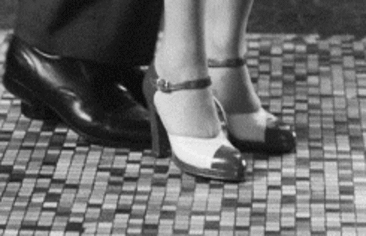
Il en va de l'érotisme comme de la danse : l'un des partenaires se charge toujours de conduire l'autre.
- Milan Kundera
#kundera#milan kundera#quote#argentine tango#tango#dance#dancing#dancers#argentina#men#women#femme#eroticism#movement#sensuality#art#culture
2K notes
·
View notes
Text

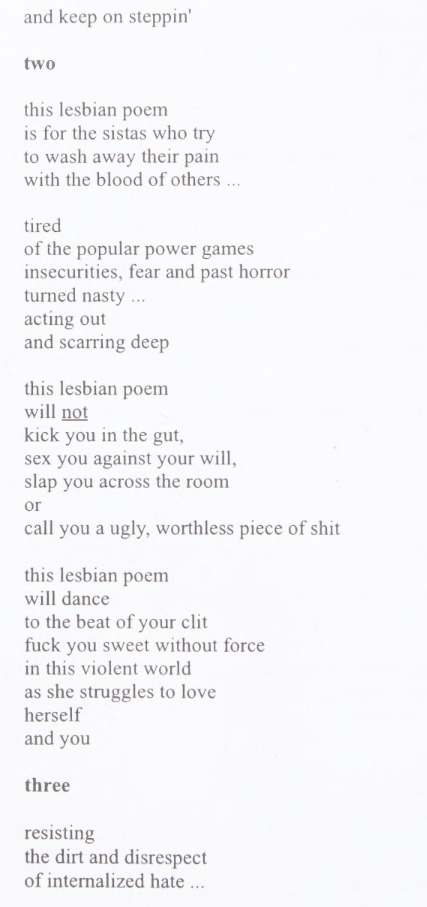

This Lesbian Poem by Akhaji Zakiya
from Lisa C Moore's Does Your Mama Know?: An Anthology of Black Lesbian Coming Out Stories
#lesbian culture#lesbian poetry#black lesbians#coming out#resisting the dirt and disrespect#maturing with the responsibility of her personal power#testifyin bout our movements#sanctifyin our unions#solidifyin our resistance
596 notes
·
View notes
Note
Please can you explain the difference of meaning between hanfu and huafu ? Sorry if you already got the question
Hi, thanks for the question, and sorry for taking ages to reply! (hanfu photo via)
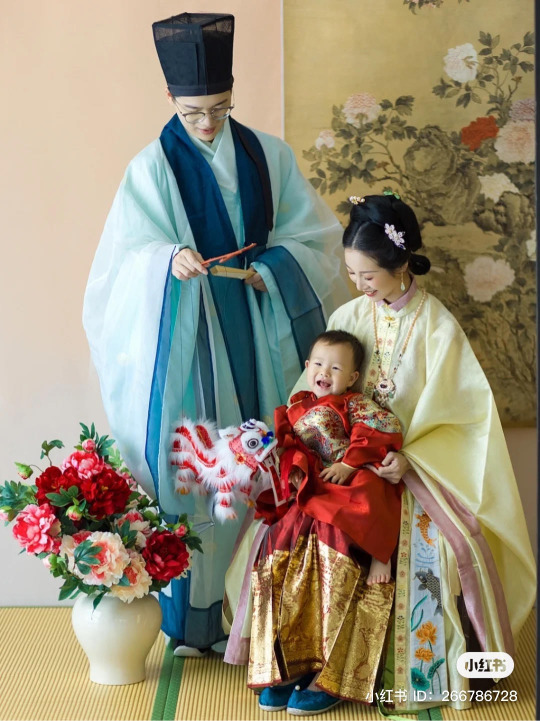
The term “hanfu” (traditional Chinese: 漢服, simplified Chinese: 汉服) literally means “Han clothing”, and refers to the traditional clothing of the Han Chinese people. “Han” (漢/汉) here refers to the Han Chinese ethnic group (not the Han dynasty), and “fu” (服) means “clothing”. As I explained in this post, the modern meaning of “hanfu” is defined by the hanfu revival movement and community. As such, there is a lot of gatekeeping by the community around what is or isn’t hanfu (based on historical circumstances, cultural influences, tailoring & construction, etc). This isn’t a bad thing - in fact, I think gatekeeping to a certain extent is helpful and necessary when it comes to reviving and defining historical/traditional clothing. However, this also led to the need for a similarly short, catchy term that would include all Chinese clothing that didn’t fit the modern definition of hanfu -- enter huafu.
The term “huafu” (traditional Chinese: 華服, simplified Chinese: 华服) as it is used today has a broader definition than hanfu. “Hua” (華/华) refers to the Chinese people (中华民族/zhonghua minzu), and again “fu” (服) means “clothing”. It is an umbrella term for all clothing that is related to Chinese history and/or culture. Thus all hanfu is huafu, but not all huafu is hanfu. Below are examples of Chinese clothing that are generally not considered hanfu by the hanfu community for various reasons, but are considered huafu:
1. Most fashions that originated during the Qing dynasty (1644–1911), especially late Qing, including the Qing aoqun & aoku for women, and the Qing changshan and magua for men. I wrote about whether Qing dynasty clothing can be considered hanfu here. Tangzhuang, which is an updated form of the Qing magua popularized in 2001, can also fit into this category. Below - garments in the style of Han women’s clothing during the Qing dynasty (清汉女装) from 秦綿衣莊 (1, 2).
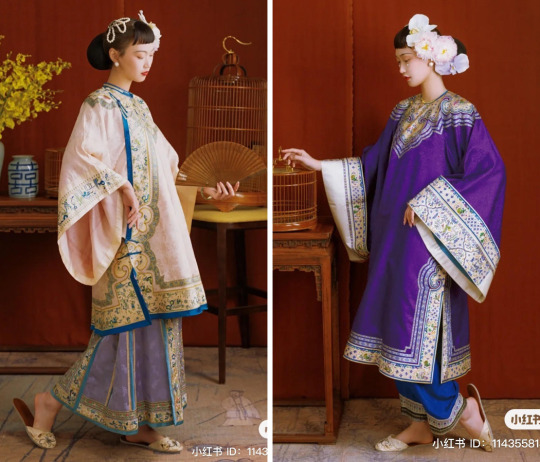
2. Fashions that originated during the Republican era/minguo (1912-1949), including the minguo aoqun & aoku and qipao/cheongsam for women, and the minguo changshan for men (the male equivalent of the women’s qipao). I wrote about why qipao isn’t considered hanfu here. Below - minguo aoqun (left) & qipao (right) from 嬉姷.

Below - Xiangsheng (crosstalk) performers Zhang Yunlei (left) & Guo Qilin (right) in minguo-style men’s changshan (x). Changshan is also known as changpao and dagua.
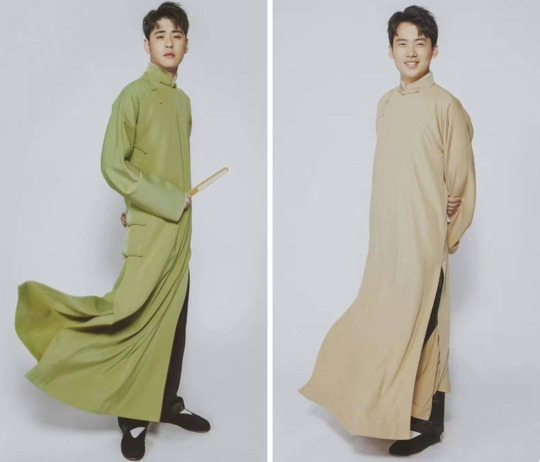
3. Qungua/裙褂 and xiuhefu/秀禾服, two types of Chinese wedding garments for brides that are commonly worn today. Qungua originated in the 18th century during the Qing dynasty, and xiuhefu is a modern recreation of Qing wedding dress popularized in 2001 (x). Below - left: qungua (x), right: xiuhefu (x).
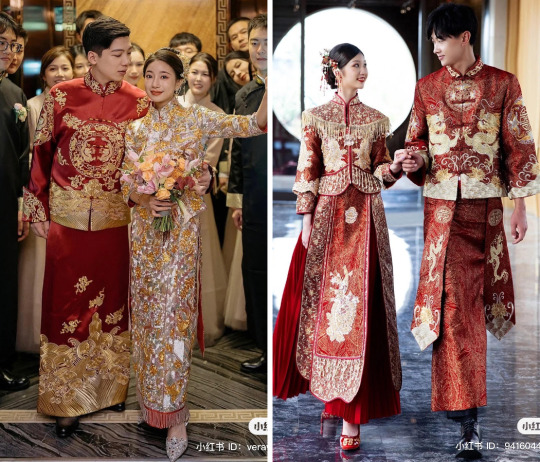
4. Modified hanfu (改良汉服/gailiang hanfu) and hanyuansu/汉元素 (hanfu-inspired fashion), which do not fit in the orthodox view of hanfu. Hanfu mixed with sartorial elements of other cultures also fit into this category (e.g. hanfu lolita). From the very start of the hanfu movement, there’s been debate between hanfu “traditionalists” and “reformists”, with most members being somewhere in the middle, and this discussion continues today. Below - hanyuansu outfits from 川黛 (left) and 远山乔 (right).

5. Performance costumes, such as Chinese opera costumes (戏服/xifu) and Chinese dance costumes. These costumes may or may not be considered hanfu depending on the specific style. Dance costumes, in particular, may have non-traditional alterations to make the garment easier to dance in. Dunhuang-style feitian (apsara) costumes, which I wrote about here, can also fit into this category. Below - left: Chinese opera costume (x), right: Chinese dance costume (x).
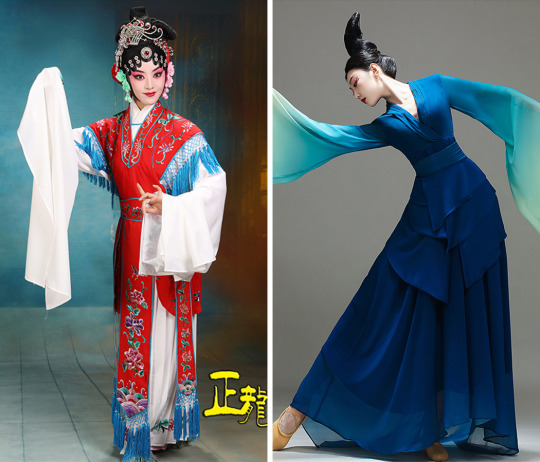
6. Period drama costumes and fantasy costumes in popular media (live-action & animation, games, etc.), commonly referred to as guzhuang/古装 (lit. “ancient costumes”). Chinese period drama costumes are of course based on hanfu, and may be considered hanfu if they are historically accurate enough. However, as I wrote about here, a lot of the time there are stylistic inaccuracies (some accidental, some intentional) that have become popularized and standardized over time (though this does seem to be improving in recent years). This is especially prevalent in the wuxia and xianxia genres. Similarly, animated shows & games often have characters dressed in “fantasy hanfu” that are essentially hanfu with stylistic modifications. Below - left: Princess Taiping in historical cdrama 大明宫词/Palace of Desire (x), right: Wei Wuxian and Lan Wangji in wuxia/xianxia cdrama 陈情令/The Untamed (x).

7. Any clothing in general that purposefully utilizes Chinese style elements (embroidery, fabrics, patterns, motifs, etc). Chinese fashion brand Heaven Gaia is a well-known example of this. Below - Chinese-inspired designs by Heaven Gaia (x).
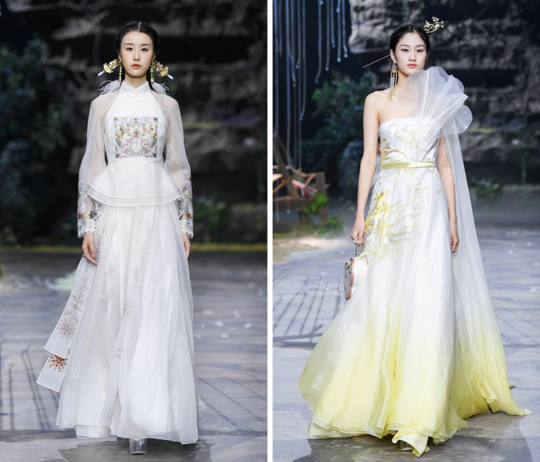
8. Technically, the clothing of China’s ethnic minorities also fit under the broad definition of huafu, but it’s rarely ever used in this way.
From personal observation, the term “huafu” is mainly used in the following situations:
1. Some large-scale events to promote Chinese clothing, such as the annual “华服日/Huafu Day”, will use “huafu” in their name for inclusivity.
2. For the same reason as above, Chinese clothing including hanfu will often be referred to as “huafu” on network television programs (ex: variety shows).
3. A few Chinese clothing shops on Taobao use “huafu” in their shop name. Two examples:
明镜华服/Mingjing Huafu - sells hanfu & hanyuansu.
花神妙华服/Huashenmiao Huafu - sells Qing dynasty-style clothing.
With the exception of the above, “huafu” is still very rarely used, especially compared to “hanfu”. It has such a broad definition that it’s just not needed in situations for which a more precise term already exists. However, I do think it’s useful as a short catch-all term for Chinese clothing that isn’t limited to the currently accepted definition of hanfu.
If anyone wants to add on or correct something, please feel free to do so! ^^
Hope this helps!
#happy 2023!#hanfu#huafu#terminology#language#hanfu movement#history#reference#ask#reply#>1000#chinese fashion#chinese culture#china
2K notes
·
View notes
Text


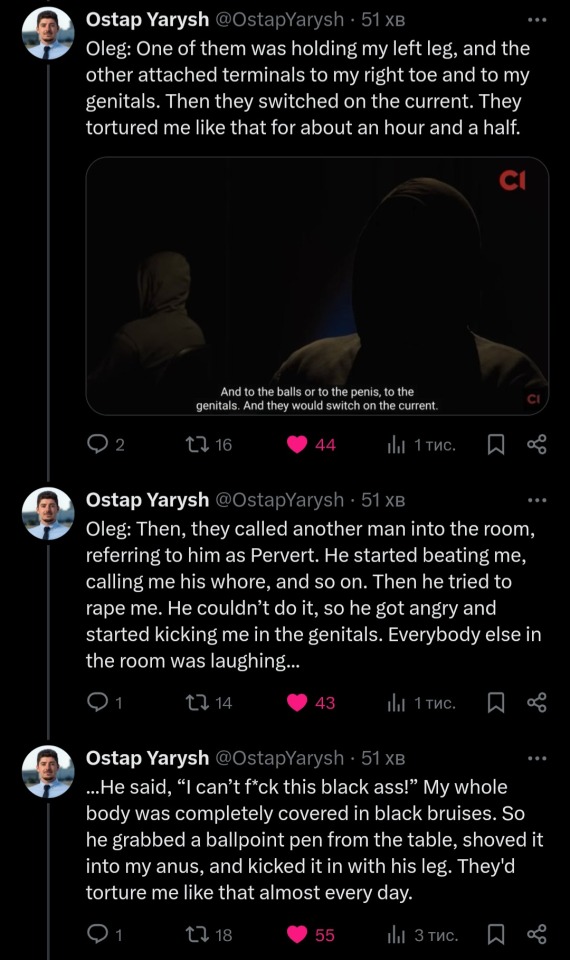

TW rape, assault
russians are raping and commiting sexual violence against Ukrainians. Don't let their crimes be forgotten, don't let the pain of survivors be ignored.
#ukraine#russia#russia is a terrorist state#genocide#fuck russia#stand with ukraine#support ukraine#genocide of ukrainians#russian war crimes#russian culture#me too movement
180 notes
·
View notes
Text

#fuck diet culture#joyful movement#intuitive eating#anti diet#self care#self compassion#mental health
560 notes
·
View notes
Text

#coretta scott king#black history#black tumblr#black excellence#black community#black literature#civil rights#black history is american history#civil rights movement#black girl magic#equal#equal rights#black culture#beautiful black women
367 notes
·
View notes
Text
The reason a lot of punks don't associate themselves with punk is becose of all of those ,,punks" that see punk as just music and close and are mean and sadistic towards normies. First punk is a political movement before anything else second people who dress basic and listen to popular pop artist are just as human as everyone and we should be nice to them and everyone else and if you don't think that sorry but you are a poser.
#punk rock#punk music#punk rock music#punk posting#punk shit#punk fashion#punk kid#punk community#punk culture#punk movement#punk
223 notes
·
View notes
Text
I CAN'T be the only one that thinks the way lightsabers look when the Jedi swing them through the air looks really beautiful, so hear me out.
Lightsaber dances.
It's a century old tradition in the Jedi order, and a popular hobby for the younger members of the order.
The dances involve either moving your lightsaber in specific ways to make forms and visual tricks with the saber. The movements themselves are based off (if they aren't already) acctual fighting techniques.
The tradition has multible functions. For one, it's orcourse the fun factor for everyone. The Jedi doing the dance and the people watching them. Lightsaber dances are also often used to teach the younglings the basics of lightsaber fighting in a fun and active way. And even for older Jedi it still serves as a nice and light training in terms of concentration and swift movement since you gotta be aware of your blade at all times inorder to produce the best visuals.
If you do them with a partner they serve as great exercise for getting intune with the other since broth parties have to look after the other and themselves to not bumb into eachother or mess up the steps as they perform.
And last but not least, they also serve as a sort of rememberance and honoring ritual. Jedi incorporate and mimic fighting stances and attacks of those they either wish to honor or remember into dances and perform them for those they made them for.
Since usually it takes a lot of concentration to do these dances it's a way of saying "look, I did all this because I deeply respect you. And I also build in movements like yours to show that I pay attention to you and care about you."
Some lineages even have their own dances, each generation adding their own move to it. Each Jedi takes pride in being able to show the history of their lineage. It also serves as a connection between the generations at the temple.
Each padawan learning their lineage dance and adding to it can say that he made this with Jedi long before them and will have made it with Jedi long after them too.
Then when the war starts and Jedi start to form close bonds with the clones, it's only natural they add them in the dances.
Ofcourse there are no lightsaber stances or techniques the Jedi can mimic to put into their dances. So they do their best to mimic the movements of clones when their fire or advance.
#jedi culture#lightsaber#lightsaber dances#Grey nearly cries when one day a very excited Caleb insists on him watching his dance#and Depa explaining that her padawan worked really hard to figure out what kind of movements would immitate the clones the best#because he also wanted to honor the clones when he honored fallen Jedi heros in his dance '
88 notes
·
View notes
Text

Hoop earrings are a staple of Latina and Black womanhood, as well as a stylish piece of jewelry for all of the other sisters!💜
#history#hoop earrings#mesopotamia#jewelry#ancient#womens history#femininity#african american women#latina#black power movement#american history#feminism#chola#women empowerment#black girl magic#girl power#latina culture#black femininity#latina femininity#coquette#womens history month#second wave feminism#sisterhood#african american history#black culture#just girly things#united states#earings#nickys facts
45 notes
·
View notes
Text
the consequences of tiktok trending any kind of social movement

#ok i’ve seen a bunch of posts claiming we’re taking this too seriously- i thought it was FUNNY!! haha SILLY! not a comment on the culture#just a comment on tiktok#6b4t#4b movement
45 notes
·
View notes
Text
“If I'm a bitch, then I'm a bitch. If that's what an assertive woman is to you.” -Christina Aguilera

#christina aguilera#xtina aguilera#xtina#pop culture#pop music#bionic#bionic album#feminist movement#feminism#feminist#divine female#divine feminine#divine woman#sexy goddess#girl blogger#girlblogging#feminist quotes#life quotes#quotes#woman quotes#women quotes#misogny#britney spears
35 notes
·
View notes
Text
It has frequently been observed that terror can rule absolutely only over men who are isolated against each other and that, therefore, one of the primary concerns of all tyrannical government is to bring this isolation about. Isolation may be the beginning of terror; it certainly is its most fertile ground; it always is its result. This isolation is, as it were, pretotalitarian; its hallmark is impotence insofar as power always comes from men acting together, "acting in concert" (Burke) ; isolated men are powerless by definition.
Hannah Arendt, The Origins of Totalitarianism
#hannah arendt#the origins of totalitarianism#quotes#Been chewing on this book lately for a paper -- breaking down the connection between#americans & american culture testimonies as feeling more isolated than ever and the ever present rise of#far right movements & propaganda and anyways!#lots to think about#reading 2023
270 notes
·
View notes
Text
i know chase obviously wins the religious trauma competition but can we please talk about how foreman was not only raised by a deeply religious father, but was most likely raised BAPTIST. no wonder he’s so repressed. the baptist experience is like. you’re in church every sunday listening to a man scream about how love is something that should hurt. you believe in a good, loving god - but to believe, you have to accept that true love is painful. that to be a good person, you must suffer. to love is to endure it, to work mercilessly. you’re not worthy of the love of The Almighty, and you never will be, and that sense of unworthiness is fundamental to having faith. when you sin, you don’t just hurt Him, you hurt everyone around you. you make the world worse because you have dared commit the sin of existence — to be human is to be sinful. to be loved is to feel unworthy and pathetic and hopeless. like YEAH no wonder foreman self isolates and is emotionally closed off. he was taught from BIRTH that he is fundamentally unworthy of love, and that in accepting love, he is also accepting that he truly is worthless.
#also#i really cant stress enough to non-americans that foreman being black would seriously have had an impact on his relationship with religion#christian ideals are baked into the way racial justice is thought about in the blm movement of today#christianity is also by and large more significant to black americans than it is to white americans because of this#because race and religion are really intertwined#and idk its not. the MOST important aspect of foreman’s character or anything#but i think it’s a lot harder to Get him if u don’t have that cultural knowledge which most americans will inherently understand#also disclaimer im not black. never been to a black church so obviously i cant speak to that experience#however i did go to a baptist school growing up and they REALLY emphasized that i should be ashamed of being alive#obviously this is all me theorizing bc foreman could be some other flavor of protestantism#they’re all varying levels of traumatic tbh#if he was episcopal he probably was listening to people speaking tongues in church which just. yeah. that also really fucks u up#house md#eric foreman#house md hc#house md headcanon#dr foreman
118 notes
·
View notes
Text
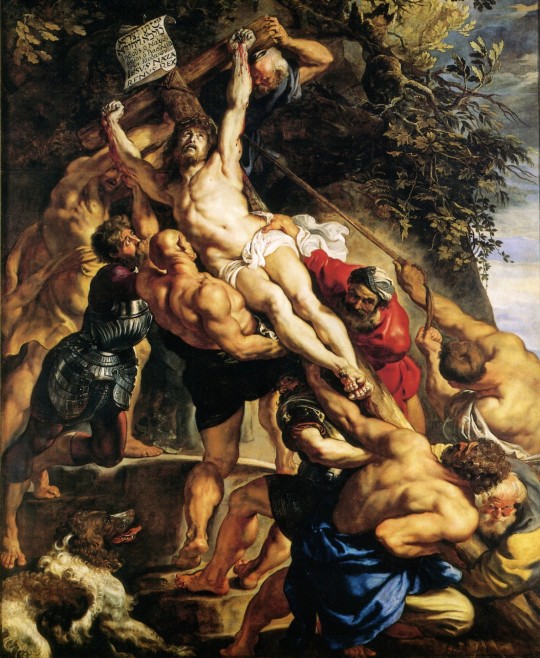
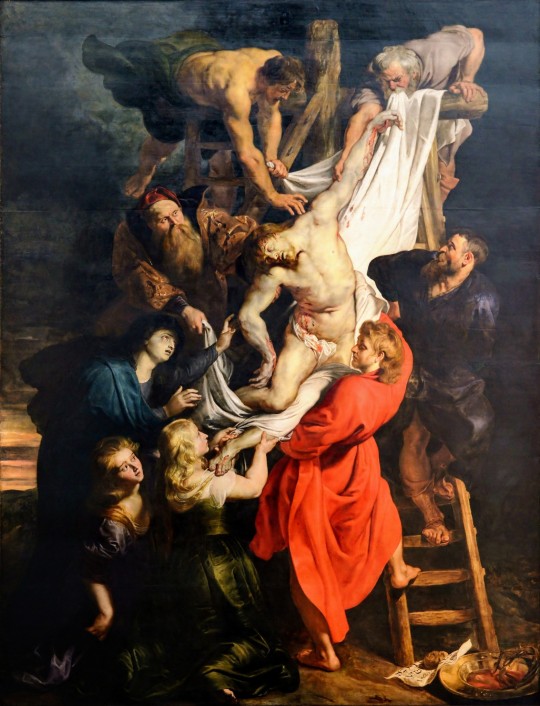
Peter Paul Rubens. Top:The Raising of the Cross (1611). Bottom:The Descent from the Cross (1613). (See notes for more details.)
#art history#anatomy#graphic art#design#composition#movement#history#religion#faith#painting#culture#christianity#jesus#art#peter paul rubens#michelangelo#bible#17th century#baroque#oil painting#🎨
268 notes
·
View notes
Text

#protect the black woman#black girl magic#black literature#black excellence#black tumblr#civil rights#black community#black history#civil rights movement#black girls rock#black girls#black pride#blackexcellence365#black history is american history#black archives#black culture#black girls are beautiful#black lives matter#black is beautiful#equal justice#equality#equal#facebook#instagram
2K notes
·
View notes
Text

Made some pins for my new jaked
#punk rock#punk music#punk movement#punk fashion#punk aesthetic#punk jacket#punk rock music#sex pistols#70s punk#anarchism#punk style#punks not dead#punk as fuck#punk#leather jacket#punk culture#punk chick#punk clothes#punk community#punk diy#punk is not dead#punk girl#punk outfit#punk posting#punk shit#punk kid#punk vibes#pins#jacket#baby punk
117 notes
·
View notes